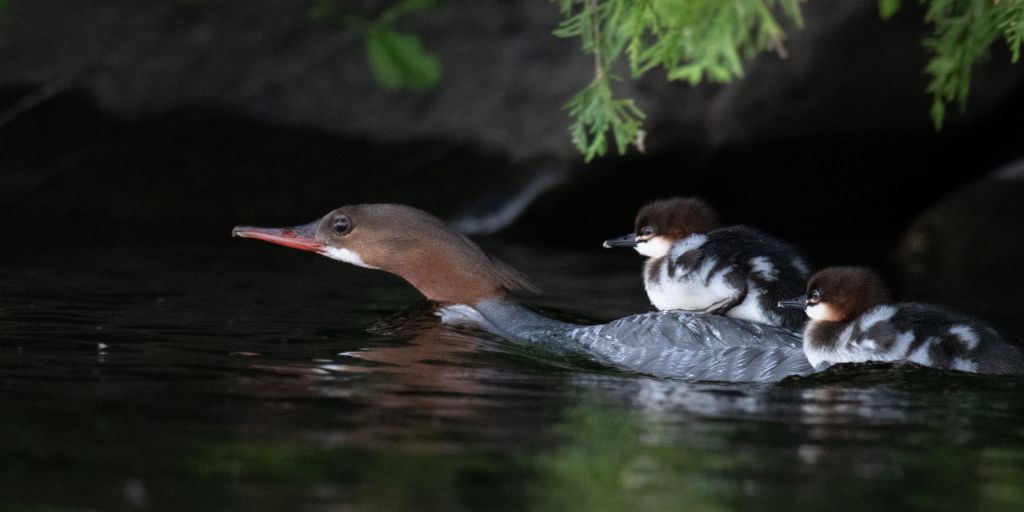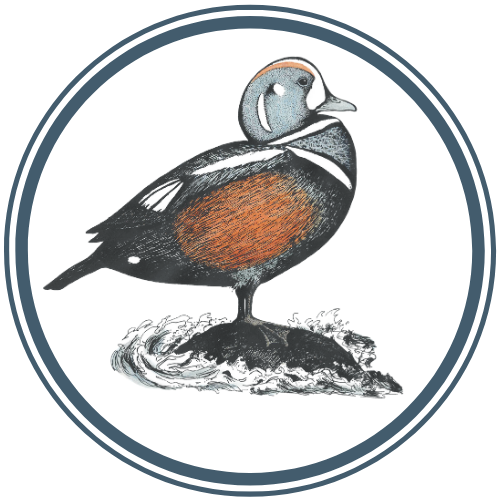Nature Notes: A Maine Naturalist Afield

Host: Logan Parker
Producer: Glen Mittelhauser
The final opportunity to document breeding Red-breasted Mergansers arrives, but events take an unexpected turn with the shifting of the wind.
Transcript
The waters of Northwest Cove were glassy as I set out for one last attempt to document Red-breasted Mergansers breeding in Moosehead Lake in late July of 2022. Following the now familiar course north along the western shore of the cove, I planned to push further north than I had on any previous attempts before turning back at Drummond Cove, just below where Carry Brook emptied into the lake. Throughout the morning, I encountered only another Common Merganser hen with her entourage of small ducklings.
It was near midday when I reached the small bay below the remote township of Seboomook. Stray breezes from the west were rolling the lake surface into rounded furrows which gently rolled beneath my kayak. Stronger gusts were forecast by mid-afternoon, by which time I aimed to be bumping along back towards home. I knew now that there was a good chance I would depart disappointed, having unsuccessfully located any additional signs of breeding Red-breasted Mergansers since encountering a pair back in late June. I formulated a plan to salvage what time I had left. I would beeline my way south and cut straight across the cove openings rather than cling tight to the shoreline. Once at the boat launch, I could scan for waterfowl as the conditions allowed and, with the field season swiftly nearing its end, accept the outcome – mergansers or no. Putting this plan into practice proved more challenging than anticipated, however.
Shortly after turning south, I found myself struggling to stay on course and began drifting eastward. The high limbs of the trees hedging the western shore had begun to bend and rattle. The wind whipped up so suddenly that I found myself nearing the center of Moosehead’s Northwest Cove among frothing surf. Rounded ridges gave way to sputtering whitecaps, each slopping generous heaps of lake water into my kayak. The expected winds had arrived unexpectedly early.
For fear of overturning my kayak if turned against the wind and waves, I followed the direction the wind selected for me and paddled East. With the wind at my back, I paddled hard, towards relative safety, but away from help. All the while, the lake sloshed and tossed the unsuitable “day-tripper” kayak and I felt increasingly aware of how deep and dark the water looked. I refused to let myself panic and focused on one thing: paddling. Keeping a straight line was impossible so I instead prioritized staying upright and moving forward. As I approached the eastern shore, I could see the waves breaking on a predominantly boulder-strewn, densely treed shoreline. Propelled by the wind, my choice of landing places dwindled, however, I spotted a 10’ span of pebbly shoreline overhung with cedar and settled on it. The stones crackled as I plunged the nose of the kayak into the beach and then hinged parallel with the shore. I clumsily scrambled to safety, pulled the kayak ashore, and sat exhausted a large driftwood log to take stock of my situation and surmised that I wouldn’t set foot on the western shore anytime soon.
Staring west from my driftwood bench, I took in the horizon. An armada of cottony stratocumulus clouds sailed eastward while the waters of Northwest Cove glittered beautifully under the midday sun. I was able to get an update out to my wife and to Glen, both sending me forecast details for the rest of the day. The strong winds would persist until at least early evening – perhaps 6 or 7 hours from now. Well, I would have to make the most of the opportunity. No one had yet atlased this stretch of riparian woodlands before. Besides, with many hours of daylight before me, I had ample time to make progress towards my eventual journey back across the lake. With that, I made up my mind to haul my kayak one and a half miles southwards along the shore towards Seboomook Point. From there, I would decide between paddling out to Seboomook Island or else making a straight paddle across the cove. In the meantime, I would cling to the shore and keep my eyes out for waterfowl and ears open for songbirds. Loading my gear into my kayak, I turned onto a mossy carpet of the cedar swamp to begin my trek.
The going wasn’t easy. Dense thickets of alder, tight bunches of broomstick-trunked conifers, and narrow, unstable and often steep shoreline made for challenging travel. Weaving back and forth among the trees with my kayak dragging behind was clumsy, tiring work, but I made regular stops to rest in view of the water to scan for birdlife. The wind made listening for birds difficult and the choppy lake surface was far from ideal for scanning. Wanting to stretch the food I’d packed for the day, I snacked on freshly ripened blueberries and bunchberries as I moved between each subsequent landmark I selected.
A handful of waterfowl sightings throughout the trek buoyed my hopes somewhat while my eagerness to reach the opposite shore grew. To shave off some more travel time and give my arms a break, I waded a few feet offshore in sheltered coves so that I could tow my floating kayak behind. By 5 o’clock that evening, I was just a few hundred yards from Seboomook Island. While the winds remained steady, to my great relief, they were abating. I resolved to reenter the water and paddle to the island to stage my eventual crossing. There I would wait out the last of the winds in the lee of the island. Dropping my kayak into the water, I pushed off the rocks and left the eastern shore for good.
Related Episodes
-

7/13/25: The Hunt for the Red-breasted Merganser, part 1
A noteworthy observation on Moosehead Lake sparks a determined effort to document one of Maine’s rarest breeding waterfowl.
-

7/20/25: The Hunt for the Red-breasted Merganser, part 2
The search for mergansers continues and leads to lake isles crowded with colony nesting birds on Maine’s largest lake…
-

8/3/25: The Hunt for the Red-breasted Merganser, part 4
After being temporarily stranded across Moosehead Lake’s Northwest Cove, Logan set out to Seboomook Island and the conclusion of…



